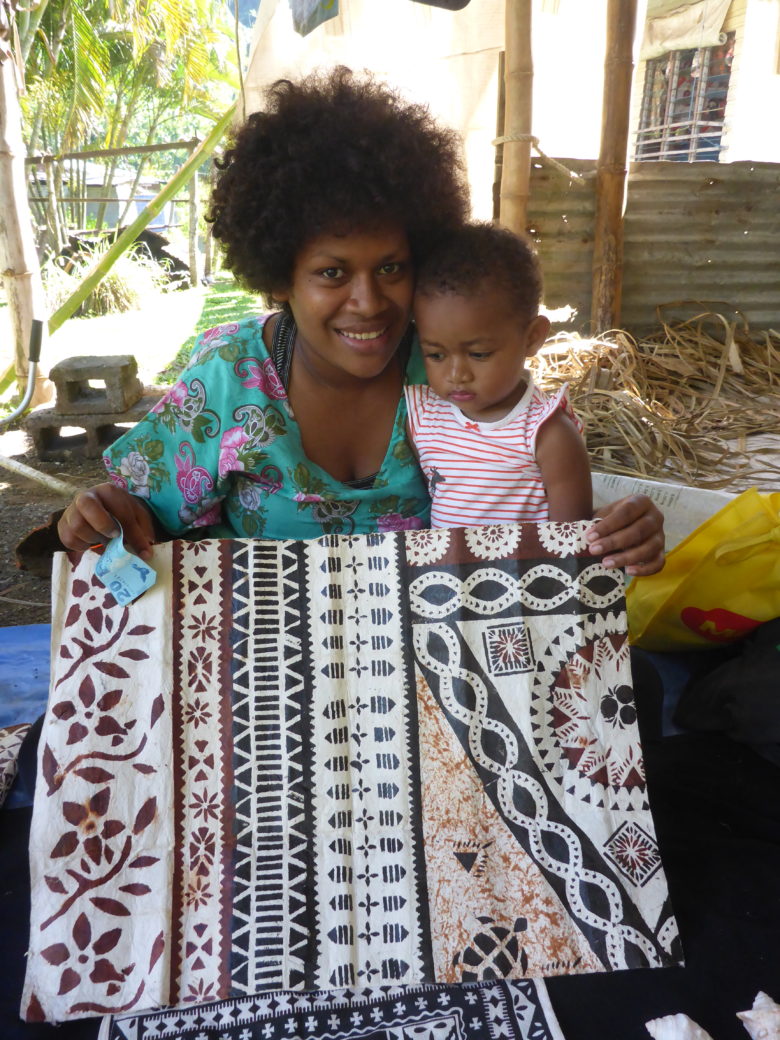With our friends Alison and Randall
The promise of another beautiful day was creeping into the dawn sky and giant fruit bats circled over their daytime treetop roost next to our mooring field.

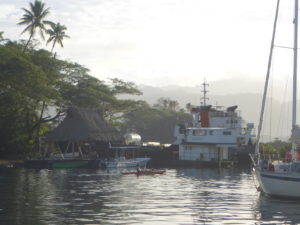
I had awoken around 4.00am and knowing that I wouldn’t sleep anymore in the stifling cabin I closed the door behind me, opened the big windows in the saloon to let in the cool night air and climbed into the cockpit for a look at the night sky. Despite the low level white lights on the shore the starry scene was full of interest. Satellites moving across, the flashing lights of planes, Mars again bold and orange and Orion in the sky further up Nakama Creek poised and pointing directly down onto our friends Jane and Greg in their yacht, Orion.
We had agreed to meet Alison and Randall for an ornithological expedition which killed two birds with one stone (!) for us because since our arrival we had wanted to look over the area from an elevated height up in the hills.
We scored an impressive 12 birds thanks to Alison’s extensive knowledge of them and her use of a handy small reference book. So here they are;
Numerous lesser Frigate Birds, we recognised having seen them many times before, Fiji Wood Swallows, a common Mynah but not close enough to hear what he was saying, White Rumped Swiftlets, Red-vented Bulbil, Spotted Doves chatting on a telegraph wire, a Wattled Honeyeater nosing into bright purple blossoms, a Polynesian Triller perhaps on his vacation, A fabulous Collared Lory, A Vanikoro Broadbill, an Orange Breasted Mytomela and a Fiji White Eye. Not bad for a morning’s work. The photo shows frigate birds.
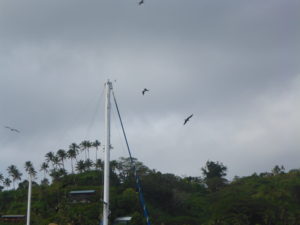
The sightings were hard earned though, the sealed road soon petered into soil and passed some pretty homes clutching the hillside and with ever improving views as we climbed higher up the precipitous track. Only healthy feet and four by fours could make it up here.
One man was putting in a day of labour on a new extension to his home and came over for a chat. He pointed to a bend in the track beyond which we should take a series of directions to convey us to the top where there was a lookout.
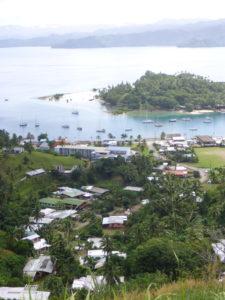
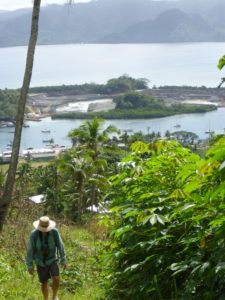
Perfect we thought but then around the bend was a choice of tracks, some of which we found led just to peoples’ homes. One was so steep that when we turned to come down again as it would have taken us in for breakfast with an alarmed family, I completely lost it and slid down on my flip flops my hands stretched out behind me gathering soil and acting as breaks. Randall kindly loaned me his blue kerchief to wipe the sweaty soil from them.
We struggled up another promising incline and stopped for a breather and to wipe the sweat from our stinging eyes. But this time we broke through and the reward was worth the effort, as the photos will show. A red soil track wound along the ridge of the hills and we wandered to the other side to have our suspicions confirmed, there was the Pacific, the shore hugging reef and the little tarmac airstrip that serves the island of Taveuni.


Two vehicles went by carrying families likely on their way to or from church or the mosque maybe. We soaked up the views right over Savusavu Bay and far to the east before snooping into the homes of the folk who live on the hill.

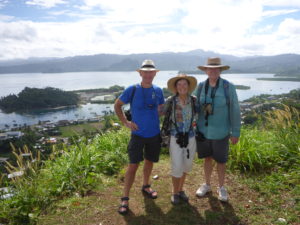
Two sermons were being shouted vigorously from within shady rooms but one other sounded more like a man having a row with a silent foe. A lady sat cross legged in the garden under the shade of a tree minding a little girl and escaping the tirade. It was too hot for such vocal exertion.
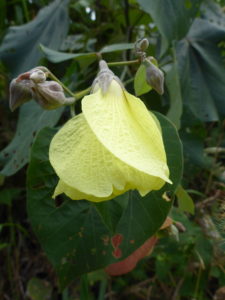
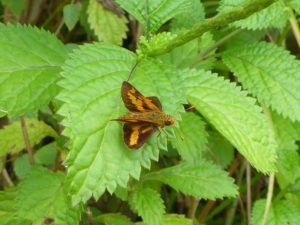

We found ourselves on the pavement beside a perfectly tarmacked road serving the airport. On the steep hillsides were very upmarket homes, the most affluent we had seen.
Alison and Randall were off to Curly’s three hour seminar in the afternoon and Alison took the pictures of Curly for us. We sat for a refreshing beer at the Waitui Marina and chatted with Pedro who is setting off in Jade soon non-stop for Washington, keeping west to pick up the north Pacific Tradewinds to carry him home. Jade has a few rigging issues which he (and we for him) hope will not worsen on route.
In the evening of this perfect day Greg and Jane from Orion came aboard for supper and we started on our four year catch up. What we had all being up to since we were together on the ARC Portugal Rally in 2014.
Taiyab takes us on a Tour
Taiyab is pictured in number 979 and I think you may agree he has neither the looks nor physique of a father of three mature sons and I told him that. He learned to drive only four years ago and that skill combined with buying a 5 seater pickup truck (at nearly twice the cost as in New Zealand) has transformed his life. Instead of being employed and subject to wages and hours of work dictated by others he is now his own boss.

In the past few years he explained that vehicle ownership has rocketed bringing all the usual advantages and disadvantages, remember our queue outside the sugar mill!
The first stop for our small group of Alison, Randall, Rob and me was outside Mum’s Kitchen opposite the bus station and market hub, to collect four vegetarian curry wraps for our lunch. Then with the windows wide open we sped a few miles along the Cross Island Road until we reached a little red soil track that led down a steep valley towards the Savusavu Bay shore.
All the villages we have so far seen are kept pristine clean and are clearly loved by their regular daytime inhabitants. This one, which may have been Thorolo, was no exception. Once the children and workers have left, the elders and young mums with their babes pursue their daily round.
The latter were sitting on large woven pandanus mats in groups under vast shady canopies, some chatting while making craft items ready for selling from the ‘shop’, another well shaded area of communal activity.
I shall call her Maya as none of us asked her name and it suits her. Maya is a single mum and she is paid a little by the village for hosting visitors. We walked along clean concrete paths over soil terrain covered in a neat, flat broad-leafed ‘grass’. With the recent rains had we not kept to the path the area would have become a muddy quagmire.
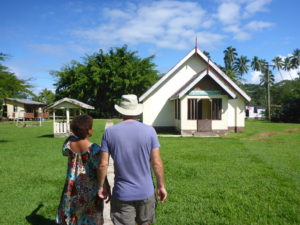
Maya explained that part of the communal living culture meant that if one villager was short of food then all they had to do was visit a neighbour who would provide for them. This is typical in indigenous cultures.
Maya then entered a tiny little open walled hut and very gently tapped a hollowed length of log with two thick sticks. It made a resonant sound that when used in earnest, three times on every Sunday, was the villagers call to prayer in the church.
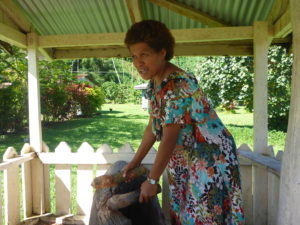
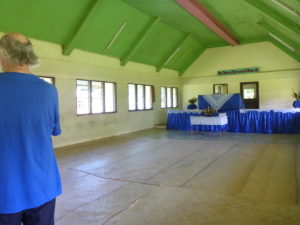
A little further on is their creek which enters the bay a few metres away. Floating around a vast shady tree were the bamboo rafts the men used when they went fishing at night. The fish are smoked in crinkly tin smoke houses that hug one outside corner of each hut. Most of their food is home grown and their only major purchase outside the village is electricity, which Maya enjoyed so she could light her hut in the evening.
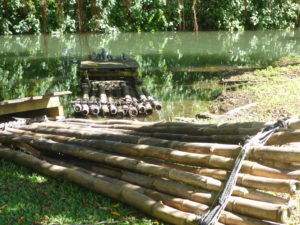
On our way back to the pickup we took off our shoes to enter the handicraft ‘gazebo’ where young ladies sat cross legged behind their jewellery, fans, bowls and matts. One ‘masi’ mat took my attention because it reminded me of similar versions we had seen in Tonga. The bark of a young mulberry tree is crushed and then crossed over itself and pummelled into a tight weave until a paper like area is produced ready for decorating with their home-made choice of mango stencils.
I bought one for $20fj from a young mum whose daughter Rosie sat on her lap and had been sucking mum’s milk until we turned up. The atmosphere in the village was so ordered and peaceful and the women’s harmonious lives in each other’s company was slightly enviable. See featured photo.
Taiyab then drove us to a clearing on the other side of the track and we walked the short distance to the waterfall passing plants with fuchsia coloured leaves and a healthy green leafed plant we were told was the Kava plant. The root is harvested and laid to sun dry on crinkly tin before being ground into the powder that make the drink I have mentioned.
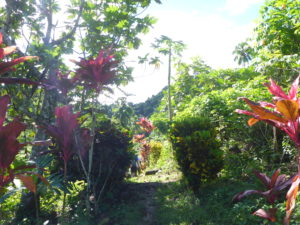
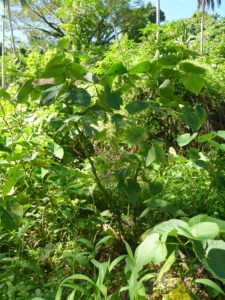
The rainforest here at these lower levels is more open and palm oriented than higher up in the hills. Up there one can take treks for a number of hours which are strenuous, steep and very slippery after rain, so we stayed on what we knew we could manage.
The fall water was cool bliss and the bottom of the pool was smooth pebbles. Taiyab did not swim as it was too cold for him, “I will join you in the hot pool,” he said as he sat on the wooden form guarding our lunches and the box of sliced coconut and dates he had brought for our snack.

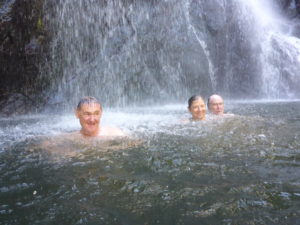
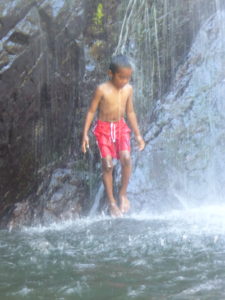
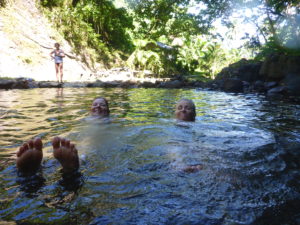
Soon a large group arrived with children whose verbal enjoyment gave us our reason to leave. We’d had our fun in this tranquil spot.
Refreshed and nourished we drove a few kilometres further until an escaped steer slowed our progress as it ran down our side of the road. As we approached it dipped its head toro style ready for the charge, which with his healthy horns could have seriously damaged Taiyab’s pride and joy, so he spun the wheel and nipped past smartly.
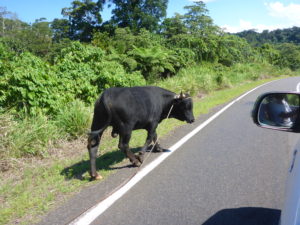
A local and his dog came to say ‘bula’ before strolling off into the jungle to chop something for supper with his machete while we prepared for our hot pool bath. It was hot too and areas of the soft weed covered bottom were really really hot. Alison impressed us all by walking the entire length of a fallen palm that lay on the surface right across one side. Dirty Dancing Fiji style.
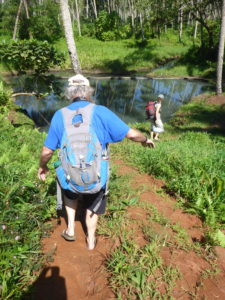
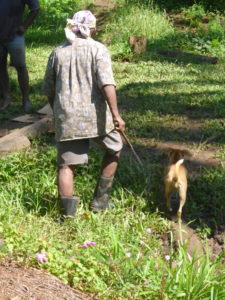

Today, the 20th July 2018, we will leave this lovely place and anchor for just one night in the Jean-Michel Cousteau anchorage before setting off eastwards for some cruising. I’d like to say more about Savusavu but really the next best thing if you are interested is for you to visit!

A Bientot Savusavu – Bonjour Jean-Michel Cousteau Resort
16:48.67S 179:17.25E
We did a big market and supermarket shop and had supper with Jane and Greg our Australian friends from Orion last evening with the promise we would take them up on their kind offer to stay with them in Newcastle when we fly in to Sydney at the end of the year.
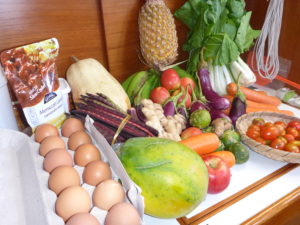
After three fine weeks staying in that gem of a place we were ready to move on and dropped the hook near the resort started by Jacques Cousteau’s son many years ago. They are very laid back about yachts anchoring and snorkelling around the rocks. We took Alison across to the split rock again so she could feel the nipping Scissortail Sergeants along with countless other species she identified that had been just beautiful fish to us.
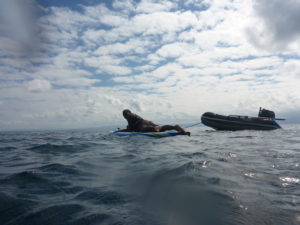

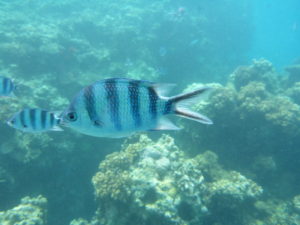
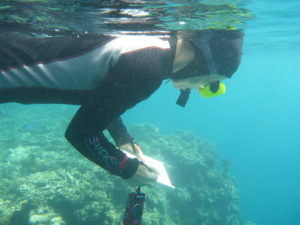

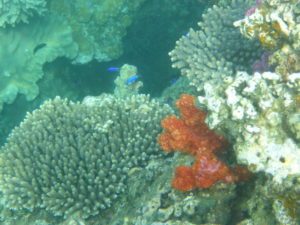

The anchor chain ground into the locker in darkness the next morning. Our route out was on the chartplotter from when we arrived so no worries there. Although the Baliwalu (eight night wind) of our arrival was now a distant memory, there was still a generous supply of wind for the day, 17 – 22 knots so we sailed well offshore, on Curly’s advice, until we could do a decent tack along the coast which turned out to be on a bearing of 56 degrees.
As we neared the coast on an ever decreasing angle we then tacked out to sea again until the BTW, Bearing to Waypoint, became 51 degrees when we were assured we would make the entrance to our destination Fawn Harbour on the next tack.
Approaching the channel between reefs around mid-afternoon with the sun ahead we could make out the darker water where we needed to be and very slowly followed the waypoints we bought from John Martin of the Island Cruising Association and found there were some posts that confirmed our route.
“Yacht entering Fawn Harbour if you bear to the right at the next post you will have the anchorage facing you, don’t go too far in as there is a reef, just by the catamaran (his) you’ll find deep water.” The mystery voice came from a man standing on the veranda of his very nice shore-side home between the mangroves, binoculars in one hand and handheld VHF in the other. How helpful I thought.
John came out in his dinghy once we were anchored and told us the cat is his and he plans crossing a few oceans in it soon. He has homes he needs to check on in Whangarei, others apart from this one in Fiji and more in Hawaii. He waved expansively across the land saying that it was all freehold and privately owned. The native Fijians do not have a chief in their village and their sevusevu is nothing more than a ploy to extort from the cruisers. Just how ingenuous were his comments we were not to know, but he was disparaging about the locals.
We met John and his Danish wife again the next day.
16:43.59S 179:43.72E
Why ‘Fawn’ Harbour I Wonder?
I looked right through the limited list of useful Fijian words translated into English and they do not appear to use the letter ‘F’, instead many of their island names start with ‘V’ which has been Anglicized to ‘F’ eg Vulaga becomes Fulaga and is pronounced Fulanga. The assonance is there, Fulanga sounds very similar to Vulanga, the Fijian word doesn’t it. So ‘Fawn’ must be the English meaning either the colour, creature or the verb to exaggerate affection or the Old English ‘fagnian’, making or being glad. Thank you Mrs COD 2011 (Concise Oxford Dictionary), but we’re none the wiser.
The sound ‘F’ seems to be a European introduction just as Whangarei is pronounced Fungarey with a soft ‘G’, so following that line of thinking I looked to no avail for Fijian words like ‘vawn’ or a similar spelling that might explain a Fijian meaning to the name. It also begs the question where did the name Fiji come from?
In our well sheltered anchorage we were surrounded by a thick band of mangroves before the topography rose up the slopes of an ancient volcano to the broken ridge, thickly forested with native trees right to and over the top. You get this feeling with Fiji that those forested hills will forever remain so, a sanctuary to all the species of flora and fauna that live there. The same as in the reefs, the colour and variety of the corals and fish are affected only by cyclones and I hope there is never enough pollution in the oceans to affect the ones in this locale.
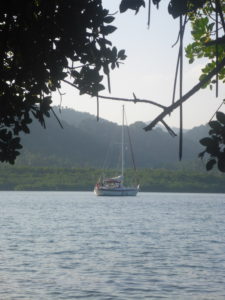
We visited the little islet near us with Alison and Randall to find it lightly farmed with Papaya and Coconut palms. There were lots of potential ankle busting crab holes. At night this little place would be alive with activity. On the mounds of excavated earth around the holes were shells flicked aside by crab claws and these shells were highly ridged.

I remember while visiting an island made of spoil from dredging deposits off Corpus Christi in the Gulf of Mexico back in 1977 seeing similar shells whose shape was familiar but were also deeply ridged. It was explained to me then that they are shells in the process of being pushed down into the seabed by the newer deposits on top and they could be tens of thousands of years old.
These mini dredgers were doing the same as the mechanised ones in the southern US, bringing history back to the light of day.
Rob rowed us all across to John’s catamaran where we met his charming Danish wife for a short chat. John proceeded to question the authenticity of the sevusevu ceremony and concluded with the throw away comment that snorkelling to the east was spectacular and we shouldn’t worry too much about the few shark attacks that have been reported in the waters to which we were heading!
We had in the back of our minds of course the dangers of this paradise, the coral reefs to be negotiated and the rocks and coral heads hidden in the waters. What looks like an open expanse of sea, the likes of which we are well used to, are no such thing in this area as the telling line of white breakers along and between us and the horizon warn us of the shallows beneath. But these reefs can be as protective as they can be destructive, like a bipolar friend they can offer safety, security and sheer enjoyment inside their lagoons but make a mistake with them and the consequences are obvious.
Like everyone else we were taking our beloved floating home into these areas and as I find the anticipation of an up-coming event is usually more painful than the event itself we would proceed with carefully measured caution and the hope that our fears would be tempered as we gained experience.
I used to tell my nervous learner driving pupils on the day of their test that the anticipation of the test was usually much worse than the test itself. “When you get out there you will be too busy to feel nervous.” Some even returned saying they quite enjoyed the experience, especially if the examiner was a friendly one who knew how to put them at ease and more especially if they passed!
In the same way Rob and I would be pooling our joint knowledge, experience and eyeball navigation to keep Zoonie safe. We weren’t alone of course as we also had the minds of our dear friends Alison and Randall to listen to and fill the holes in our learning.
We already had Open CPN on our laptop, which is a free navigation system with Google Earth overlaid on to it in places. You cannot get more accurate than photos from above the earth. How often did past navigators wish they could look down on the earth to see their way forward from above?
Rob installed the GPS dongle onto this system so we could actually see where Zoonie is in relation to the overlaid charts, well that is the theory. Our outdated CPN Charts of this and other areas can be inaccurate, as we have found by as much as 1 kilometre, so by following the trustworthy and tested waypoints we have been given from Curly in Savusavu and Jon Martin of the ICA that Rob has installed on the charts it looks as if Zoonie is crossing land!
Much like childrens’ dot to dot games we follow the shaped track formed by joining the dots and have to transpose it on to the chart by moving the track east or west to allow for the chart error. The easiest way is to ignore the land mass on the chart and look just at the designated track and the land mass around us. Even then the ultimate safeguard against disaster is the eyeball as we were to find out on entering Vanua Balavu later on.
Cyclone Winston in 2016 did phenomenal damage in Fiji and guiding posts shown on charts are not always there, also it must be remembered that they are on rocks or reefs themselves and so need to be given space.
16:45.04S 179:53.87E -The Reefs, Rocks and Coral Heads of Viani Bay
I felt just a little apprehensive about our next anchorage as rocks and coral heads are far from the ideal bedmate for Zoonie’s anchor and chain. However the day dawned gorgeous and we had a nice leisurely start at 11.35am to motor in light airs the 20 miles to Viani.
The anchor came up a treat and it was easy to follow the black line on the chartplotter back out the way we had come into the bay. Curly’s patent lure caught us a little tuna which I quickly filleted and put in the fridge for later use.
We could see the paler turquoise water where the reefs lay and the white frothing seawater breaking as it washed into the rim, alarming and re-assuring at the same time. The course by sight through the reef involved a bearing on a headland infront of us and a white cross on the hillside of Taveuni behind.
It was not easy to line them up when Zoonie was between them but the invisible line I steered along was exactly on our waypoints marking the entry and with Rob up at the bows reef spotting we made it. Once inside the reef we had deep dark blue water again across the lagoon and past a very attractive double gabled house on an isthmus of land, apparently owned by Bob the American who visits only once a year, as May told us the next day.
The anchoring area of choice faced onto mangroves which usually means mud (we like nice sticky mud and firm sand for our anchoring) but there was a reef between us and comfort, so down went the anchor into deep water where we couldn’t see the bottom and whatever hard obstructions on which we might be getting tangled up.
We were given in New Zealand a brilliant A5 size brochure of Fiji written and composed with cruisers in mind and in there I found the phone number of a Diva Academy here that sounded as if they could organise a snorkel trip for the four of us on to Rainbow Reef the next day, another one of the World’s Top Ten, which we passed on the way in. The outside of this reef is The White Wall, but that was for divers only.
We are using that brochure for so many things except perhaps navigation. Frankfurt born Marina answered her phone and immediately gave the impression our wish was her command. Their dive master and captain, Siti, would collect us from our boats the next morning at 10.00am. Perfect.
We spent 50 minutes on the first snorkel with May leading the way towing an orange float behind her. Siti stayed nearby in the boat chatting to the few other boats that were floating bases to mostly diving groups.
Never before have we seen so many types of coral or species of fish in such big numbers, it was positively crowded with fish out there. The coral heads were colourful gardens of healthy corals, soft corals of the palest purple and circles of black, white and tan like stretched cow hide to describe just two.
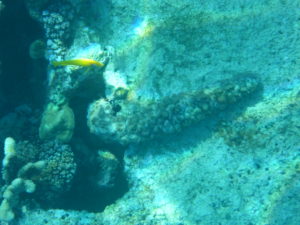
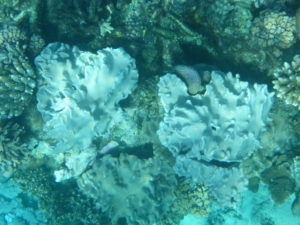

Alison had with her the volunteer reef survey clip board and an underwater marker. She would frequently dive down to see the fish nearer the seabed and record and photograph them as she did so. She counted 96 different species of fish. We spotted an eel but no reef sharks, we weren’t complaining.
As we sped back from the reef to the Dive Academy base May told me she was born in a hospital in Labasa and educated at the school next to where the new Academy/Resort is being built, before boarding at the high school on the big island opposite, Taveuni. From there she went to university in Suva studying marine biology and catering. She now lives a five minute walk from the academy, in an idyllic setting I hasten to add.

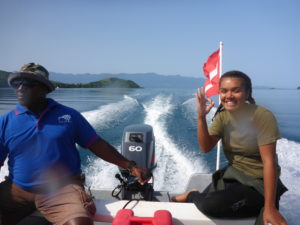
Back on the beach we sat at a table in the open air while Marina and Jone, her Taveuni born partner told us about the birth of their young business. They met by chance in a dive shop away from these shores and instantly bonded over their passion for the water and conservation. The Academy was opened at the beginning of this year and with the help of locals and the money they are making from diving they are building a small resort with small cabins, a restaurant, shop, office and dive gear room with some pretty advanced stuff like dive computers. They also train people and Jone’s specialty is a free-dive training.
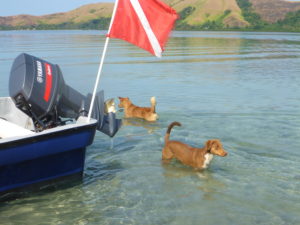




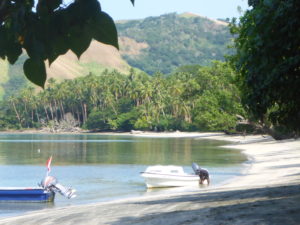
Their business is expanding as they can afford it which seems a much more secure and natural way of doing it than taking on huge bank loans. Groups of only four clients at a time are guided safely to do what they would like, wind and tide allowing. We had recently heard of a group of 18 divers going out from one base in Australia and returning to base not realising they were missing two divers.
The captain didn’t notice until he came across the couple’s land clothes and valuables three days later. Arriving at the location searchers found written on one of the waterproof boards the time and date when they were left behind, and the woman’s wetsuit. A simple head count would have kept them safe.
Refreshed with banana milk, coffee, tea, banana cake and slivers of lightly grilled fresh coconut we set off for our second reef experience in deeper water. Lots more fish but still no sharks. I wasn’t too bothered!

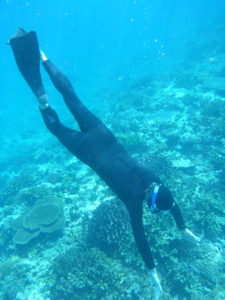

Back on shore, tea consisted of ‘monkey balls’, deep fried pancake mix with apricot jam and welcome lemon tea. Children played football with their teachers next door while waiting for their boat to arrive and ferry them home.
Later I cooked the tuna and we took it to Tregoning to go with Alison’s stir fry followed with lemon curd cookies. What a day, we were so lucky to be doing what we were doing in such fine company.
The next day we met May again in the afternoon and she took us off on a mystery trek through the rain forest. New Zealander Pam from a yacht named Kozmo joined us while Randall pursued his projects on board.
It was so pleasant walking in the tree shade. We stopped to smell the wood of a fallen Vesi tree, the Kauri of Fiji, whose hard red wood has been ideal for planking and building. Although the tree fell decades ago the wood is still sound and occasionally some is cut for firewood. A Barking pigeon was calling to its mate. They should really be called Woofing pigeons because that is the sound they make, but I guess it’s not ornithological enough a name.
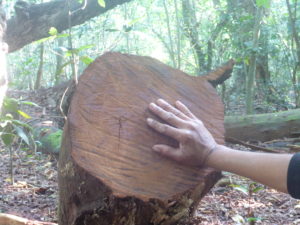
The highlight of the birds that day was the Orange Dove, with its brownish head and striking bright orange body it stood out against the green leaves so we could get some photos.
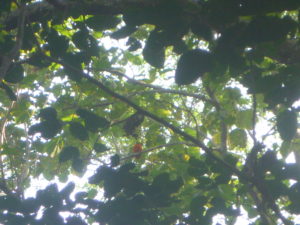
Lydia invited us into her home when we arrived at her village and gave us a demonstration of how she makes Masi matting, Tapi in Tonga, from cutting the young mulberry canes and splitting off the bark to use the inner white flesh to stencilling patterns on them using acetate film. She creates these mats to order and even makes wedding dresses in her basic forest home. Her grandson watched us as we watched Lydia.
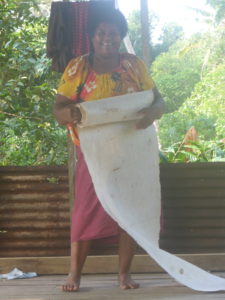
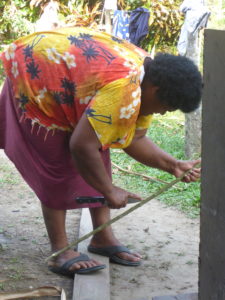
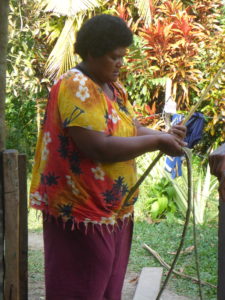


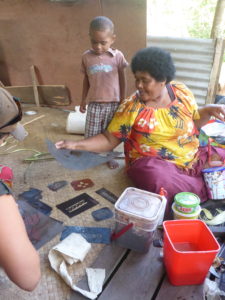


We were accompanied on the walk by Elizabeth, daughter of a well-liked local man Jack Fisher and she told us about the flora and fauna. Marina and Jone have integrated into the related local families and Marina often visits the primary school next door to chat with the 66 pupils about marine conservation, first aid and waste management issues to name but three topics.
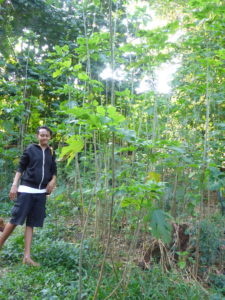
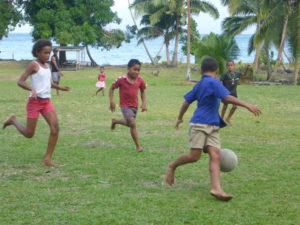
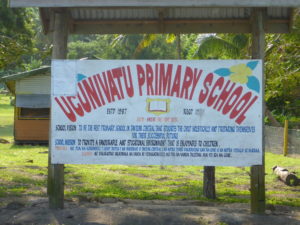
We wished them success, with their ethos of ‘giving and preserving’ they deserve it.
